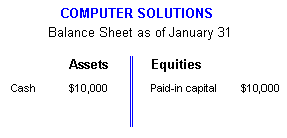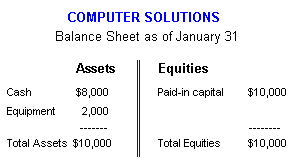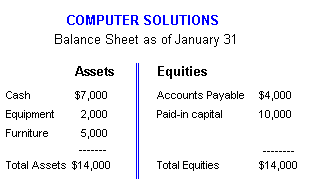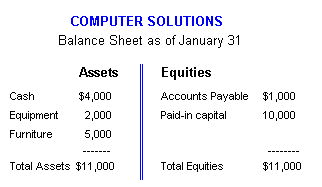How Transactions Affect the Balance Sheet
The following balance sheet illustrates how certain financial events affect it. Each event recorded in the accounting records is called a transaction. All these events occur in January.
The first event is the formation of a new entity. Assume that the owners of Computer Solutions invest $10,000 cash. As a result, Computer Solutions now has an asset of $10,000. You record this $10,000 as the item, Cash, on the assets side of the balance sheet. The owners have furnished this resource of $10,000, and you record this fact on the equities side of the balance sheet; the accounting term is Paid-in Capital. After you record this transaction, the balance sheet looks like the following:

Second, assume that Computer Solutions uses $2,000 of its cash to buy equipment. You record the $2,000 decrease in cash by making the Cash item $8,000, and you record the new asset equipment in the amount of $2,000. After you record the transaction, the balance sheet looks like the following:

This transaction increases one asset and decreases another asset by the same amount, so the total of the assets is unchanged.
The next transaction is for office furniture that the company bought. The total cost was $5,000, and Computer Solutions paid $1,000 cash and agreed to pay $4,000 to the vendor in two installments. By providing the asset furniture to Computer Solutions without receiving the full amount of cash in return, the vendor in effect furnished funds to the company. Put another way, the vendor has a claim against the assets of $4,000. An outside party (other than an owner) who has a claim against the entity is called a creditor. The amount of a creditor's claim is called a liability. The name of the liabilities arising from a vendor's claim is accounts payable.
This transaction decreases Cash by $1,000, making it $7,000. Next, record the new asset, Furniture, $5,000. Finally, you increase the new equities item, Accounts Payable, $4,000. The balance sheet looks like the following:

This transaction increases both assets and equities, but total assets still equal total equities.
The fourth transaction involves the company paying $3,000 in cash later to the vendor who had the claim of $4,000. Record the $3,000 decrease in cash by reducing Cash from $7,000 to $4,000. Record the fact that the liability to the vendor is reduced by $3,000 by decreasing Accounts Payable, from $4,000 to $1,000. After you record this transaction, the balance sheet looks like the following balance sheet.

Note: The total assets remain equal to the total equities.
The four previous transactions illustrate the main types of transactions affecting the balance sheet:
- The first increases assets and equities by the same amount.
- The second increases one asset and decreases another asset by the same amount, leaving total assets unchanged.
- The third increases one asset, decreases another asset, and increases a liability, but the total of the two sides of the balance sheet remain equal.
- The fourth decreases both an asset and a liability by the same amount, so the total of the two sides remained equal.
Keep in mind the following principles:
- Each transaction affects at least two items. The third transaction affects more than two items.
- After a transaction is recorded, the total of the assets side of the balance sheet always equals (or "balances") the total of the equities side. This is why the statement is called a balance sheet.
The double-entry principle is based on each accounting transaction's affecting at least two items, and after it is recorded, the total of the assets side of the balance sheet equals the total of the equities side. This principle is often called the fundamental accounting equation:
Assets = Equities
The reasoning behind this principle depends on how you view the balance sheet. Either of the following two explanations is correct.
- If equities are claims against assets, then the total amount claimed by all parties cannot be greater that the amount of assets available. In addition, the total claim cannot be less than the amount available because the owners claim whatever is not claimed by other parties. Therefore, the amounts to be claimed (assets) equal the amounts of the claims (equities).
- If equities are the source of funds and assets and are the form in which these funds are invested, then the amount invested cannot be greater than the funds supplied for investment. In addition, the total invested cannot be less than the amount supplied because all funds are invested. Therefore, the funds invested in various resources (assets) equal the funds supplied (equities).